ATW 90. Bhutan Part 1. Phuentsholing
This is the third in a series of posts I am making, which will be extended to create a book, Around the World in 90 Minutes.
Please send any comments or inaccuracies to atw90@leohoenig.com
For future posts, where I am going, follow me on facebook.com, twitter @leohoenig and Instagram @hoenigleo
When thinking of the trip to Bhutan, the first question is one of logistics. You cannot go direct to the country from the UK, so one has to go somewhere else and then change. Bhutan is one of two small countries, sandwiched in the Himalayas between India and China, and my first thoughts were to fly to Kathmandu, and then use the flights between the two capitals.
However, Nepalese football is a mess. Some of my friends spent a week there when there was a tournament, and said I should try to also go for a week. There was an international match in the Asian Cup qualification, but this was on the second stadium in the capital. The primary stadium appears to be out of use. There are no signs that a Nepalese League has restarted, since suspended due to the earthquake in 2015. Local websites show that there appeared to be an intention to restart this season, but it appears they never go around to it.
I would still like to go to Nepal, and I am looking out to see if they resume league fixtures next year.
I considered a short jaunt to India, although my mind says that this is the least sensible place to visit on a short trip. Anyway, for this season there was a FIFA Under-17 season being played there, with the result that the league season was delayed in starting. My trip was to start during an international weekend, so I checked Singapore, which also has a direct flight into Bhutan – but the new National stadium was not being used for their Asian Cup qualification game. Probably on the grounds that hardly anyone was going to watch it anyway. (They got 3,712 at Jelan Besar for the game against Turkmenistan, and surprisingly they then chose to play at the National stadium against Bahrain, with less than 3,000 turning out).
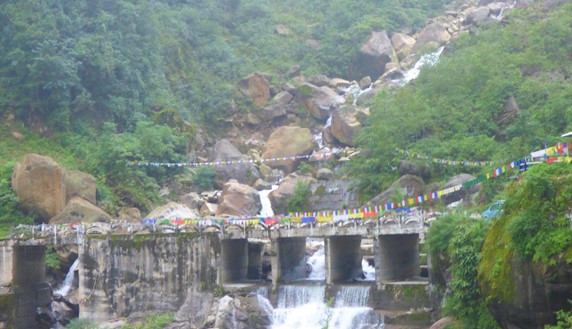
And so, it had to be Thailand – a place I am quite familiar with, but where I have not seen fixtures since they installed a proper national league structure.
The next question for anyone travelling the Bhutan is getting in and around. You cannot simply apply for a visa, book flights and hotels and arrive at the airport. Bhutan travel is dependent on booking through a tour agency, and paying in advance for all transport, hotels, meals and visa fees.
The agents must be approved by the government of Bhutan, and a full list is given on a government website. There is little information as to how to select a tour agent
Most tours take the visitors up from the capital into the mountains, and then onto a trek, while I wanted to take in football matches in the other direction. Also, I wanted to be sure the fixtures were as published on the soccerway international website.
I sent e-mails to three tour agents, chosen at random from the list. I am still awaiting a reply from two of them. The third proposed a tour, and confirmed the fixtures for the remainder of the season with the Bhutanese Football Federation. In this case, Soccerway was accurate.
The Bhutan government demands a minimum spend for everyday spent in the country. This is reduced for larger tour groups, but I was on my own at the full price. There was a delay in getting the money through the international banking system, so I ended up arriving in Cambodia on my side trip before I finally got my visa through.
For the record, a tour starting on a Friday, finishing on a Tuesday and including four nights in local hotels, and including flights to and from Bangkok cost £1655. Within Bhutan, my only expense was beer! I might have been expected to pay to enter the football grounds, but they did not make a charge. My tour guide did take me to a few places where no doubt he would have got commission if I had bought some arts or crafts, but no luck for him there.
After my trip to Cambodia, I got back to Bangkok airport around 10.30 at night, six hours before the flight to Bhutan was due to leave. I was disappointed that Thai Airways would not book my luggage through, so I had no choice but to go through customs, pick up my bags, wait until two, go through check in and security and finally board the flight to Bhutan.
This means filling in the arrival form for Thai immigration, and queuing to enter the country. I did not please the official here as I had not stated where I was staying – so I had to explain I was not staying.
The flight was in two stages, firstly to a small city in North East India, and then after a short break onwards to Paro. On the first stage, it was the fight between airlines and sleep. One is close to nodding off when they come around with the meal, and after this has one again is close to sleeping when the plane lands.
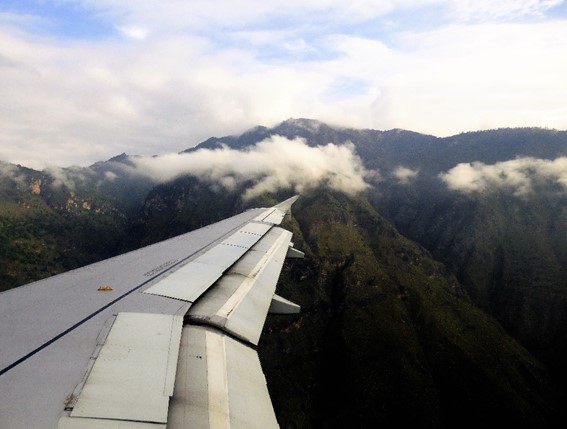
On the second leg, the pilot points out one of the world’s highest peaks to our left at over 29,000 feet. This is immediately after announcing we were cruising at 19,000! They even warned us not to be alarmed by the landing pathway, where the plane dives into the valley, with hills both sides, and then banks right to the airport.
It reminds you of the 1,762 (estimated figure) feature films where the hero is flying the plane, being pursued by the bad henchmen, and then swings violently to one side, while the other plane crashes into the mountain side.
I can tell you there was no pursuing aircraft, and although Paro is listed as one of the world’s most dangerous airports, the Aviation Safety Network reports “no incidents”.
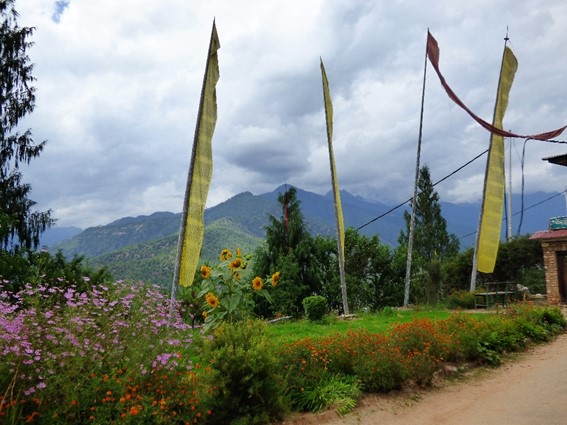
I was met at the airport by my tour guide, Yeshi, and by a guide whose name I took to be Jimmy (in my mind, to be spoken with a Glaswegian accent). I think it was really Chime. I was whisked off to the local hotel, which was in the hill above the airport. One could hear every take-off and landing, but as Bhutan does not have many air flights, and only in daylight, this was not going to stop me getting a good night’s sleep
On the first day, we took just a short look around Paro, the town posts a large Zhong (which is a local fortress) and the national museum, and two main streets, one of which appeared to be for the local shopping, and the other filled with tourist tat.
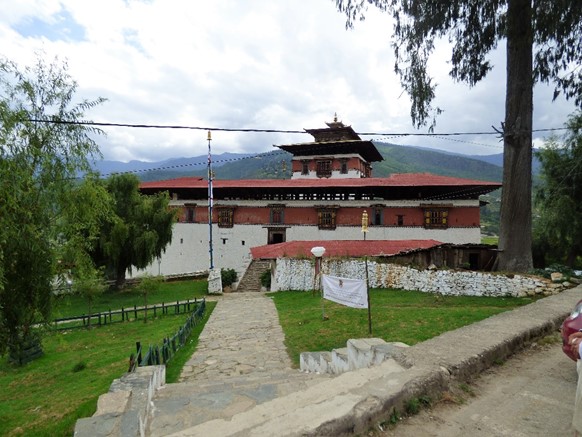
The Zhong in Paro
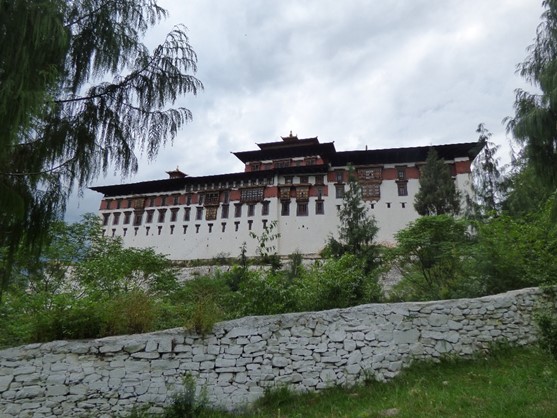
One of the features of the tourist tat on offer, is the amount of phallic art. Phalluses pictures are common sites in Bhutan, and can often be seen on the sides of houses and other buildings. This is put down to the “divine madman” the Lama Drukpa Kunley, who preached some 600 years ago, and apparently succeeded in shocking the conservative morals of the religious state of the time.
The cynic in me says that the shops in town are selling to uptight people who would tut-tut at a crude graffiti representation in the west, and who probably then hide them away. These are not souvenirs that many would place on their mantlepiece
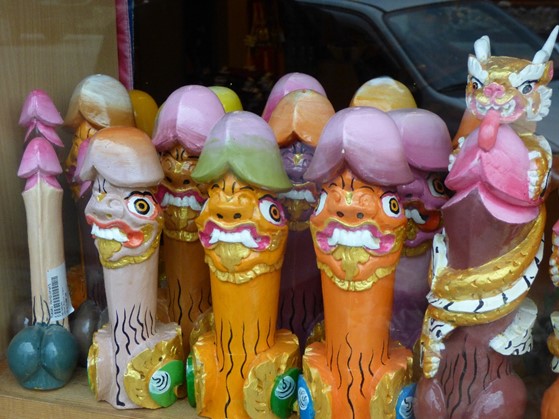
At one end of the street were the archery grounds. Archery is publicised as the national sport of Bhutan. They actually have more people involved in football, (according at least to the Bhutan Football Federation), but I think they like to show something different.
On arriving at the grounds, a match had just been completed, but we stayed for a while to watch other players practicing, and to give me a first try at Bhutanese beer, (a not unpleasant, but unremarkable lager).

Bhutanese archery is not the same as the sport you may imagine. The archers have to fire their arrows at a small target over 100 yards from their standpoint, a group of archers will fire from one end of the range to the other, and then all move down to the other end and repeat the exercise in the opposite direction.
In order to deliver the projectile with any degree of accuracy over that distance, the bows used have to be very sophisticated
. 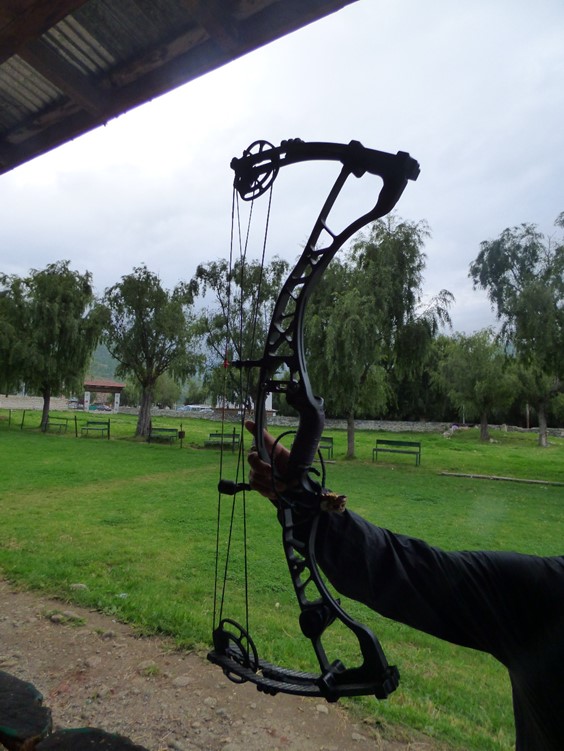
The arrows on the other hand are as simple as they come – a straight shaft, with small flights at one end, and a pointy bit at the other.
It was the next day that the adventure really started, and I got my view of Bhutan. Paro is in a valley, some 7,200 feet above sea level, (for comparison Ben Nevis is 4,400 feet). The road I would take rose about 1,500 feet from the valley floors as we found the pass between valleys, while the mountains each side of us were generally around 14-15,000 feet, about as high as the highest in Europe.
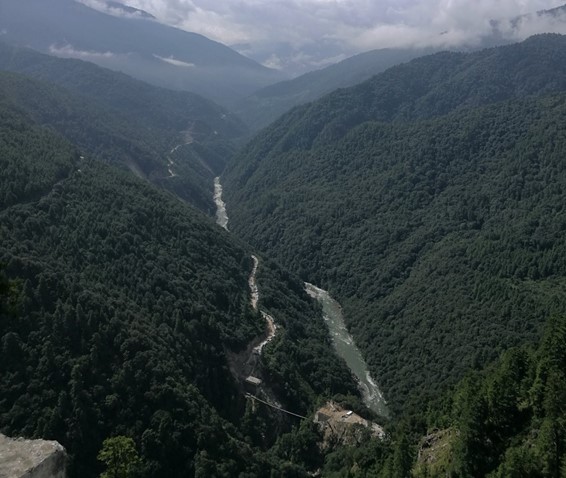
The really high mountains in Bhutan are further north than my journey would take me, but I was still surprised to pass peaks this high with not a sign of snow anywhere around, just trees all the way up to the summits. There are many ways in which Bhutan is a remarkable and unique country. The trees are the secret to one of these. Bhutan is the only country in the world that is carbon negative, that is it absorbs more Carbon Dioxide than it produces.
In Bhutan, they drive on the left. Some of the time. The driver explains his routing in keeping to the better road surface and avoiding pot holes. It also involves approaching corners where you cannot see whether or not there is oncoming traffic on the wrong side of the road. More than once, as you turn the corner, vehicles in both directions are swerving from the right-hand side of the road to the left and somehow avoiding meeting in the middle.

When we get to the narrower roads in the mountain passes, there is often hardly room to pass, without one vehicle coming dangerously close to the precipice. The potential drops make Michael Caine’s position at the end of “The Italian Job” seem like one small step. Still, all drivers assume that if you cannot see another vehicle, there is not one, and that stopping or slowing down is only considered while actually making the passing manoeuvre.
There is one thing that will persuade a vehicle to slow down. Cattle. It appears that they rule the road, and can stand or walk wherever they like. Even close to the towns it is not unusual to see a few cows wandering down the road or just taking a nap. You can blow your horn to warn a dog, a monkey, a car or a human that you are coming – but for a cow, one will quietly manoeuvre around the obstacle. You may even find someone coming the other way will slow or stop for you.
The state of the roads in places is a reminder that even the mountains are no more than a fleeting phenomenon in the history of the world. The potholes have been created by subsidence, ice, rain and rockfalls. It may take millennia to complete the process, but slowly and surely the weather, snow and ice, wind and rain is winning the war against the forces that create the mountains, and one day what are now the highest points of the earth will be reduced to gentle rolling hills.

In the meantime, the roads are being eroded on a weekly basis, and it takes constant work to keep them open. As part of the curious relationship between Bhutan and it’s southern neighbour, much of the road maintenance is undertaken by the Indian Army!
The road to Phuentsholing is one of the busiest in Bhutan, and the journey of 170 km will take four hours of driving. Bhutan depend on imports for most manufactured goods, for oil, and for some of their food. Almost all of this comes over the border from India through Phuentsholing, and then up the road we are travelling. There is therefore a constant movement of trucks, buses and cars on what is the country’s most important highway.
By contrast, Bhutan’s largest export is electricity, generated 100% from hydro-electric power stations. Especially as we started the descent to the border, the road was frequently crossed by the power lines conducting this out of the country.
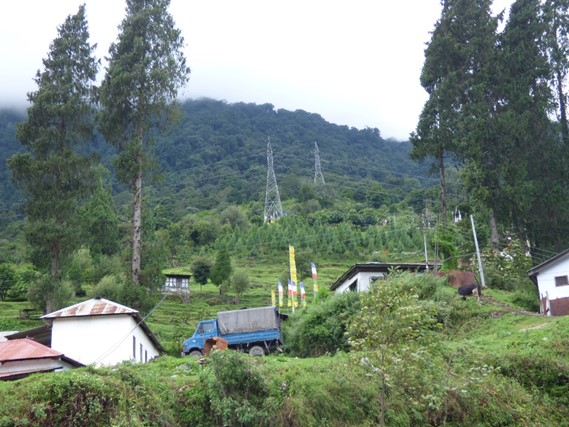
The second biggest source of foreign currency is tourism, despite the price structure that keeps the independent back packer at bay. Naturally, I asked about this, and was told that about 25% of my money went straight into the exchequer as tax, while everything the tour company paid for would also be subject to a tax (around 10%). Bhutan does not raise much tax by personal taxation. It is a country with hardly any middle class, and as anyone knows the poor do not have money to pay taxes, and the rich have lawyers to avoid them.
Bhutan provides free education and health care to all, so my tax dollars were being put to use somewhere.
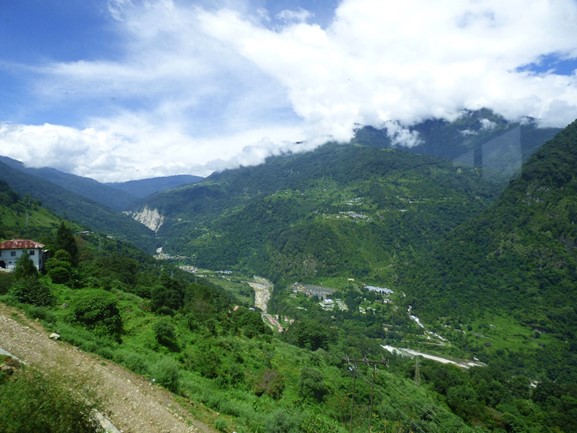
As this being the land where the measure of Gross National Happiness was invented, I asked about whether this was real, or just a gimmick. I had been disappointed that the links on the airline’s web page did not work, so I could not join their frequent flyer programme and get a “Happiness Card”. Sadly, the national anthem is a bit of a dirge telling everyone how wonderful the king is. It really ought to be Ken Dodd. The answer on the happiness question was not clear, but seemed to be about happiness coming from not desiring things you cannot have. The person who told me this, though, also said he really wanted a nice car. Meanwhile, the couple behind me in the queue at Bangkok airport for the flight checked in with two televisions, while I saw another person with a television in the line. (Apparently all electronic goods are cheaper in Bangkok, and one person can bring one TV through customs).
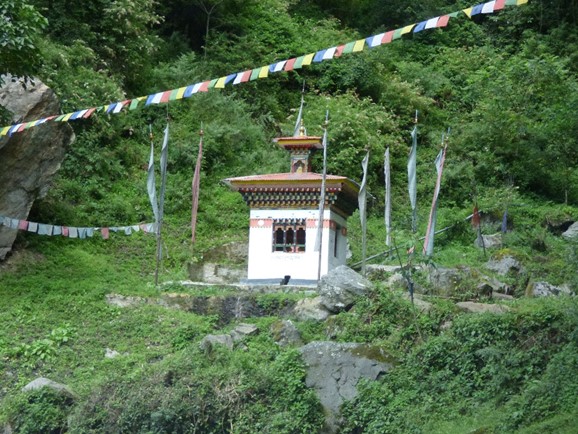
A small building like this contains a prayer wheel, allowing the illiterate to deliver their prayers. In some places the wheel is turned by hand, others can be water driven
There is a sudden change as you approach Phuentsholing, the altitude you are dropping at quickly, and you can see a bright and wide river in the distance, with the sun shining across it, it looks almost like a bank of gold shimmering in the haze.
The haze is of course, a reminder that the clean air that is a feature of most of Bhutan will not be so prevalent when one gets down to this city. By the time you arrive at the town you have dropped down, so as you are less than 1000 feet above sea level. There is a heat and humidity that one did not feel while higher up.
In addition, there are traffic jams, as lorries on both directions are trying to manoeuvre around the crowded streets, making their way in and out of the customs station. The final point is the Bhutan gate, which marks the border between India and Bhutan
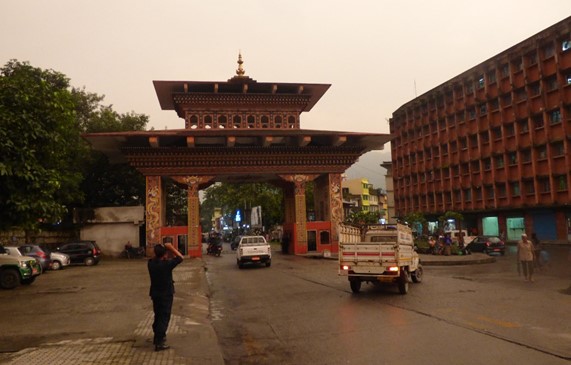
We pull off the road just to the left of the monument, I am less than a Sunil Gavaskar drive from the Indian border, but I do not have a visa to pass through the gate.
I rest up at the hotel for a while. They were supposed to provide a meal, but somehow this got forgotten. I almost misjudge the timings, as I am so close to the Indian border that my computer has switched to Indian time.
Fortunately, I do manage to stir myself in good enough time, and on my guide’s advice, we walk back up to the ground, which we had managed to spot when coming into town. The walk is less than 10 minutes, the weather is warm and humid, with a threat of rain in the air.
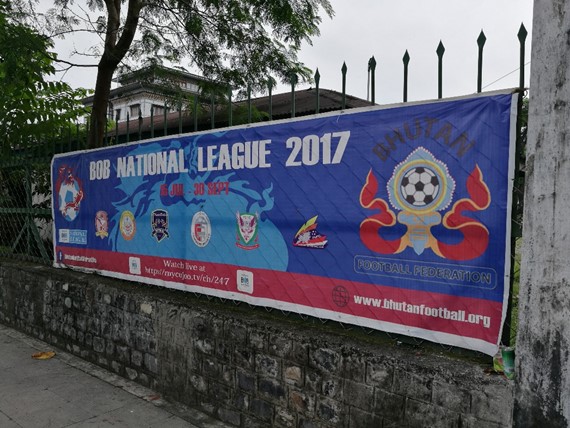
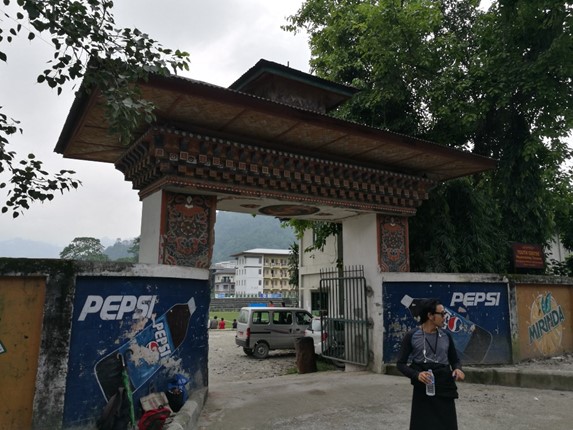
We enter through the gate, there is no admission charge. I like the ground, the stone wall and archway entrance gives it gravitas before you even enter.
Around most of the ground, there are about five steps of stone terracing. There is a building on one side with two floors, and providing the only cover from the weather. During the second half, I take some shelter there as it starts to rain. I quickly obtain a view of the visiting team list, they are the league leaders and have six substitutes named. The home side are a little more reticent. It turns out this is because they are still waiting on players to turn up.
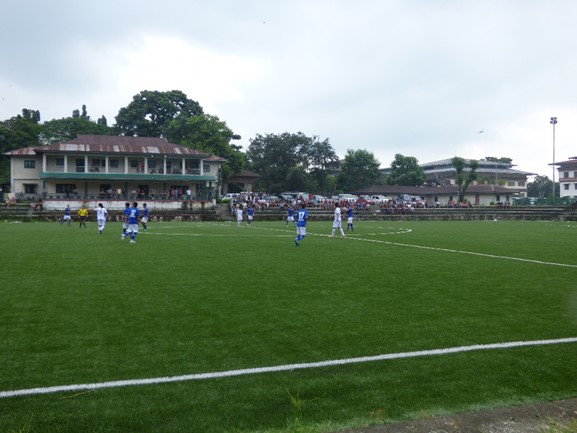

I had a clear idea of who was going to win the game before it started. It is a league with six teams, (and hence only ten matches), seven rounds had been completed before I arrived, Phuentsholing had lost all seven and conceded 57 goals to date. The visitors, Transport United had drawn the opening game of the season with Thimpu United 0-0, and then won all six of their games since.
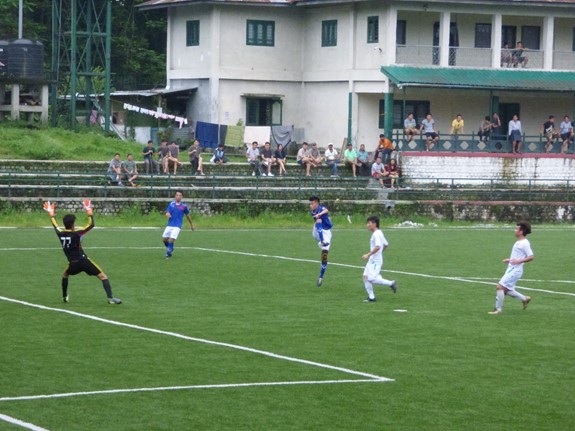
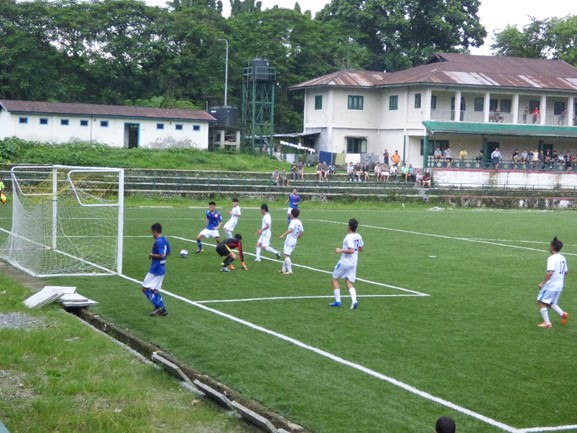
The second goal, scored by Kencho Tobgay, (who also got the first)
I eventually get to talk to Hishey Tshering, who is both sponsor and coach of Phuentsholing City. Apparently, some of the players had got stuck by an accident on the road from Thimpu (he said they were five short). I am given a list of 12 names, but when the game started, there was only ten on the field. Except the coach, there was never anyone else on the bench, so all of the players stayed on field for 90 minutes, playing in a 5-2-2 formation, and somewhat inadequate.
I got more information when I visited the FA offices. In areas such as Phuentsholing there is no preliminary competition, although they do organise some local competitions. In the main city, the Thimpu league is played earlier in the year with the top three going into the National League. I suspect that if all eight (including Tertons who had lost all 14 games) joined the National League, they would all finish ahead of Phuentsholing. Anyway, players from the five city teams that do not make it to the National League are only allowed to register for the teams outside the city. The three who qualify cannot increase their strength by signing the best of the rest.
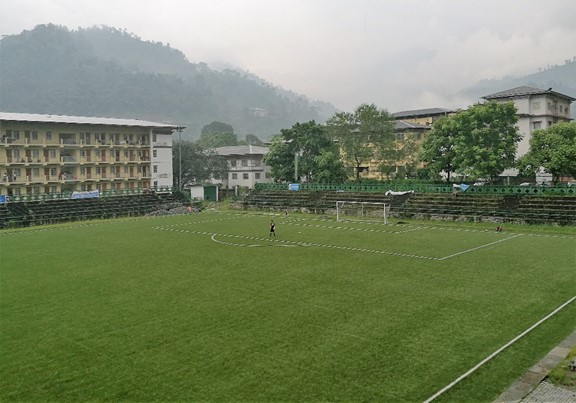

Wangdi scored Transport United’s second penalty of the game, bringing the scoreline to double figures
While most of the City League players therefore do not play in the National League, Paro and Phuentsholing each have a few. I am not sure about Uygen Academy, which is also the most competitive of the non-Thimpu sides.
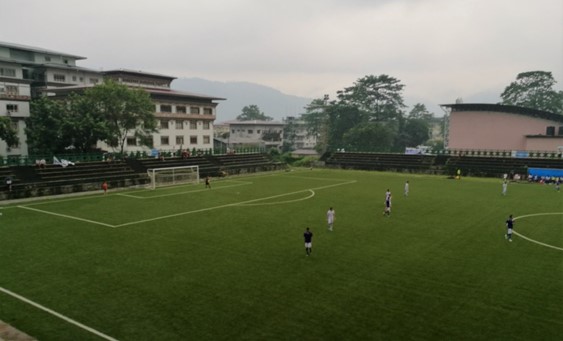
It would appear to be the players from Thimpu who had not arrived for the game. Whether this was really by design or accident is something I cannot say, and I guess now is a moot point.
It took 14 minutes for Transport United to score the first goal, and with that, the floodgates were opened. By half time it was 7-0 with Kencho Tobgay scoring a hat-trick. Tobgay completed a second hat-trick in the second half, while Dawa Tschering also scored three. Half time substitutes Sontosh and Wangdi both got onto the scoresheet, while Kingal Gyeltschen and an own goal added in to give a total of 13 away goals.
I did an estimated head count, and came up with 270. Naturally the numbers ebbed and flowed a little with it being free admission, and many did not stay until the end, more because it started to rain than because of the football on offer.

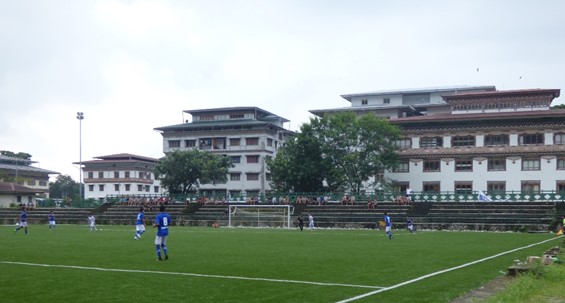
Hishey Tshering mentioned that his business was a karaoke bar in town, and I suggested to my guide that maybe I would find it for a drink later. He was very quick to advise me against this. In Paro, there was no where I could head to from the hotel, and in Thimpu he was happy to let me wander out on my own, but clearly here he felt that I was best off not doing so. How much this was to do with actual safety, and how much to do with the reputation of the bars in question is open to interpretation. The impression I get is that the much of the business done here is not selling beer.
As it happened, I never found out which bar was run by the club manager, and stayed in my hotel anyway. My guide and the driver did not stay in the hotel with me, but went to cheaper digs across the road, and later told me that they spent the evening on the Indian side of the gate.